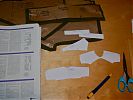After a weekend of tracing patterns and sewing kids clothes (some you’ll see later, but others are Christmas gifts not to be ruined), I finally got a chance this evening to cut out the fabric for the wool jersey top from the latest Patrones, #285, that I wrote about last week:
I came across some gorgeous ex-Prada wool interlock at Ditto Fabrics (you’ll remember them from earlier in the summer when I visited their Brighton shop) and knew I was destined to pair fabric and pattern together! (NB: if you’re planning on making this top with this fabric, buy 2m instead of the 1.5m called for in Patrones as it’s ever-so-slightly narrower than Patrones’s and I had a real tricky time fitting everything into 1.5m!) I also bought some dark turquoise ex-Burberry coating, some I-can’t-believe-it’s-not-silk ex-Prada polyester jersey with trompe l’oiel sequin print, Paul Smith grey marl jersey with stars, and some black stretch denim (all pictured at the bottom of my fabric stash gallery if you fancy a perv!). Honestly, I’m beginning to think the owner Gill is a bit like the UK version of Gorgeous Fabrics, she has such an eye for quality ex-designer stuff!
The funny this about this pattern is that on first glance, it looks like a really easy garment – just a basic blouse with dolman sleeves and some horizontal seaming in the front and back, topped off with a triangular collar with a bit of gathering detail and a covered button. Or so it’d seem. Look a bit closer at the pattern pieces and start chucking bits of the instructions through Google Translate, and it all starts to become a bit more interesting…
First of all, the top edge of both the front and back sleves have a little pleat in them, making the sleeves ever-so-slightly blouson shaped. But to keep the pleats in place, you also need a facing for the sleeve edge (which is where piece #5 comes in). And that strip of bias fabric that appears in the fabric layout? Well apparently that’s to partially bind the neck edge in the front – meaning that the front collar is actually detached in the front, allowing it to drape nicely, almost like a cowl neck.
But what really confused me was the three collar pieces. I understood that the front, triangular collar (piece #6) gatherred at one end and was joined to the tiny, nearly square piece #8 that holds the covered button (which is purely decorative, btw – you’re supposed to sew a snap underneath), but I couldn’t quite figure out how the “entire back collar”, piece #7, fit into it all since you’re supposed to cut two fabric and two lining pieces (making it even more confusing is that there’s a typo in the lining layout saying to cut it from “printed fabric” instead!). I couldn’t visualise how all the many letters and notches matched up, and it was really starting to stretch my usually quite good spatial abilities, frankly.
So I did something I’ve never done before – I made a paper model of my top! First I drew out the pieces in question – upper front, upper back, entire back collar, front collar, and the button piece. You don’t have to be perfect here, just get the shape approximately right and label all the notches and lettered corners as the pattern pieces are. As I found out later, my neck edge was way out of proportion to the edge of my collar pieces, but it’s just for your brain to get everything in the right order, so perfectly matched edges aren’t really important!
Then I got out some sticky tape and joined the upper front and upper back together along the shoulder/sleeve edge, and joined the three collar pieces together matching the letters. I then took tiny bits of tape and started matching the letters on the collar to the letters on the neck edge, which really resulted in my Eureka! moment…
Here’s the front view of the model. From piecing this together I’ve determined that you really don’t need the entire back collar (piece #7) cut in lining at all – there’s only one of those + one of the triangular front collar + the button piece in a full rotation, so the other copies are the facings. I also determined exactly where to leave the front collar detached and use the bias strip – from notch A on the right side to notch B on the left side.
Carrying on to the side view, here you can see the sleeve pleats and that the unlabelled notch on the entire back collar should line up with the shoulder seam:
And finally, the back view, where you can see that the entire back collar’s notch F matches up with the centre of the upper back piece:
I have to say, this quick and dirty method of paper modelling a conceptually tricky pattern really helped me here, and in less than 5 minutes, I was able to fully visualise how this pattern goes together. I’d amazing I never thought of doing this before, and I highly recommend it if you’ve got a similarly tricky pattern!
Finally, here’s a photo of a corner of my sewing room with three things that make me happy:
- My silk crepe chiffon overblouse with the bias-printed tartan. I promise a full writeup this week!
- Up on the wall, the sewing-themed cross stitch my mom made for me this summer, finally framed and on display!
- And in the very bottom of the photo, a working radiator!! After sewing through two winters with only a tiny fan heater and scissors and metal sewing machine so cold it hurt to touch them, I fiiiiiiinally have central heating to sew in! The ironing station is still in an unheated space, mind, but you can’t have everything!








